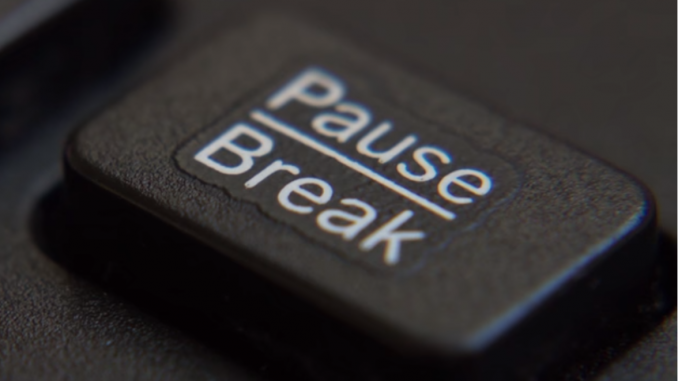
Unless you’re an Instagram trader, set with a laptop by the pool and a Lamborghini in the background, everybody goes through rough patches in trading. It is a fact.
So much of this business is uncertain, and ironically people want to get into trading for the ‘freedom’ it provides. But free we are not, and enslaved to the RNS feed at 07:00 we are. In trading, you get to tell yourself that you’re your own boss, but in reality, you follow orders from the market instead.
Everybody wants certainty in trading, but the only certainty is that the market is uncertain, and what happened today may not necessarily happen tomorrow. Therefore, it is certain that there will come a point where you begin to question if trading is for you and if you are doing it properly.
Trading droughts and rough patches come with the territory. If you are having a testing period, here are a few pointers to work through it.
Take a break

Taking a break is underrated and can often be a good emotional reset. By stepping away from the screens and allowing some time to pass, this has two effects:
1) It brings in a ceasefire on your trading which puts a stop to downward volatility in your account
2) It allows you to focus and regroup, before coming back with a clearly mind
There’s a reason certain exchanges introduce trading halts when volatility spikes. Calling a time-out in sport can put a dampener on an opponent’s momentum during the break.
However, don’t just take a break and come back to trading without having looked at the problem.
Taking a break is just the start.
Consult your trading journal

Keeping a trading journal is important, and now is where it comes into play.
If you don’t already keep one, here are a few reasons why you should:
1) It is difficult to improve if you do not have the data to hand to see where you are going wrong.
Keeping a log of your entries, your exits, your position sizing, and even how you were feeling at the time, can provide data that will help you in the future.
For example, if you realise you were feeling confident on most of your losers – maybe you were overconfident? Did that lead to higher position sizing and larger account risk?
2) You will see which trading setups are most profitable
This is important information. If I asked you what your best trading pattern was right now, hopefully you’d be able to tell me. Knowing where you’re most profitable is clearly important information in trading.
If your trading journal consistently tells you that you lose money when shorting, then the answer to improve is surely obvious: stop shorting.
This doesn’t mean that you should never short again – which is great because shorting is both fun and handsomely profitable (when you get it right) – but it does mean that in this example you would need to take the time to review your short trades and look at what went wrong.
Were you entering at the wrong point? Did you have FOMO? Did you double down against the trend? Was there a reason for the trade? All of these questions and more can be answered with a trading journal.
3) The market changes, and qualitative data in the form of your own market commentary will help to identify potential tides turning
I believe in reviewing your writing from time to time. If you notice that you were getting stopped out of breakouts, and that these breakouts were not on large volume, then that could mean either that volumes are down across the market and this could potentially be a reversal indicator as the volume is now on the short side. Being able to keep abreast of market conditions can be a big factor in outperformance.
Backtest for new ideas

Mental heuristics can be a good thing. They can protect us from danger – for example, seeing a bear shaped outline in the words can prompt us to find safety rather than actually waiting to see if it is a bear. Acting on assumptions saves us lots of time, but assumptions can also be dangerous.
Assumptions such as “it’ll go back up again” has cost many a private investor their portfolios. Assuming that gold always goes up when markets are down – does it?
When taking a break, it’s a good idea to list many of your assumptions about the market, and then backtest these using SharePad’s charting to see if your assumptions are right.
Does X + Y really equal Z? If it doesn’t, and you can exploit it, then you may have just found a new edge.
The market is full of little levers, and share prices move for many reasons. But if you’re able to find a consistent cause for a consequence – well done. Now you can take advantage of it.
Key takeaways
- Taking a break from trading when going through a rough patch is a good idea. Firstly, it puts a halt to any more losses, and secondly it lets you get recoup mental capital.
- Spending time with your journal is never time wasted. This is time that can now be used going through rich quantitative and qualitative data in order to learn something about your trading. Think of your journal as an investment in your business.
- If you don’t know already – find your most profitable setups. How can you trade more of these?
- What are your least profitable setups? Are you consistently losing on a specific setup? What would your P&L look like if you binned a certain pattern and increased position size upwards and focused instead on the more profitable patterns? What would your account risk look like if you increased your position size slightly in these plays? Plug in the numbers and see what the end result would be.
- Take a proper time-out from the market. Do something different that isn’t trading related. Everyone deserves a break at some point. You will come back feeling refreshed and ready.
- Backtest for new ideas, test assumptions, and try to find something you can exploit.
Michael Taylor
Michael has released his UK Online Stock Trading Course sharing his knowledge and how he trades the stock market. Investors Chronicle readers can take advantage of an introductory offer by visiting www.shiftingshares.com/online-stock-trading-course
Twitter: @shiftingshares


